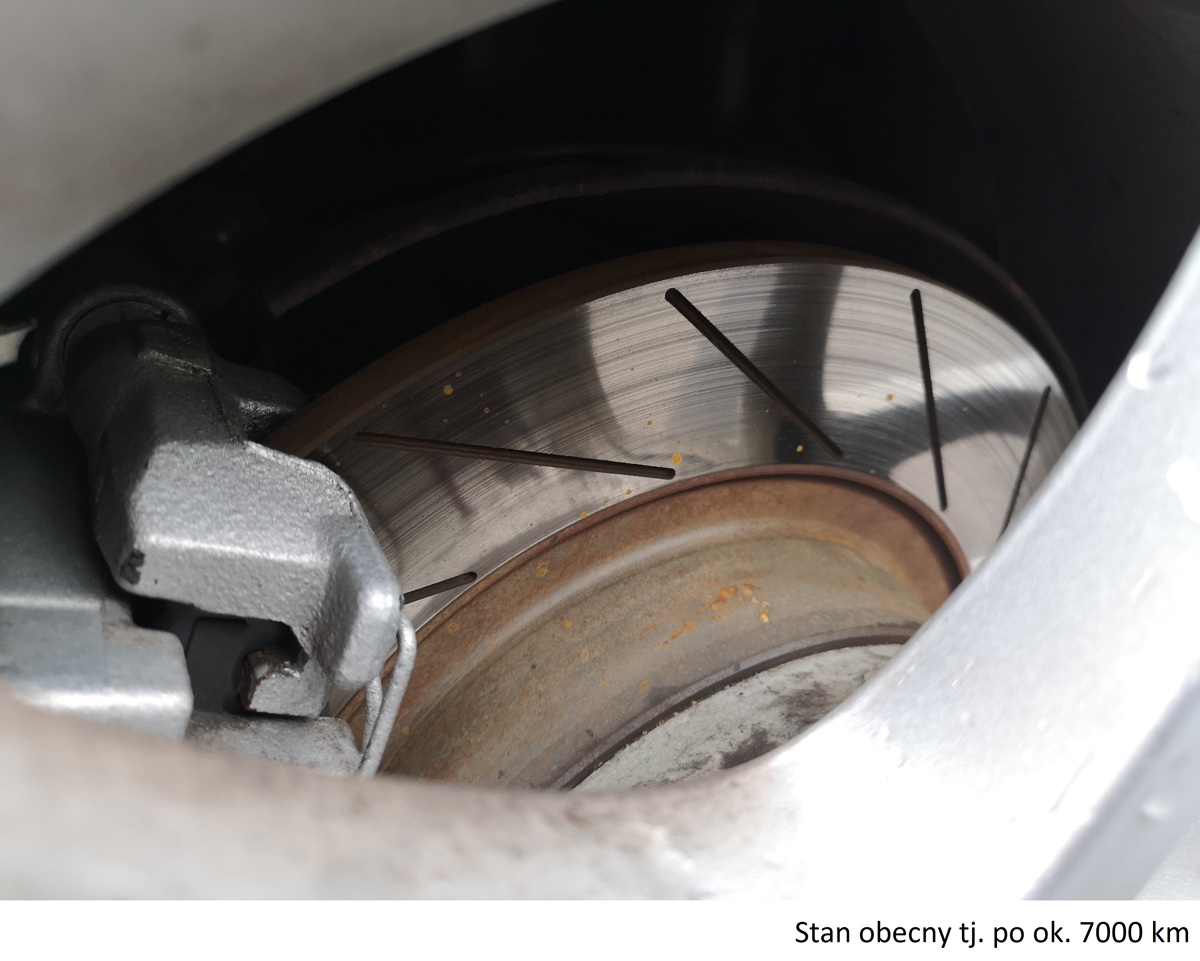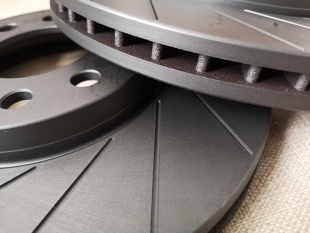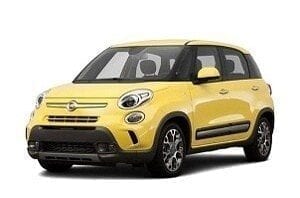
Brake discs. Testing slotted and perforated discs. Do they make sense in a normal car?
Content
 Drivers' awareness of the technical serviceability of the car and the condition of key components is growing every year and, except for extreme cases that got into motion under "mysterious" circumstances and moving along the road, it is difficult to find a car in a very poor technical condition. Moreover, many drivers decide to modify their vehicles more or less seriously. Does it make sense to invest in a braking system and, in particular, in non-standard brake discs?
Drivers' awareness of the technical serviceability of the car and the condition of key components is growing every year and, except for extreme cases that got into motion under "mysterious" circumstances and moving along the road, it is difficult to find a car in a very poor technical condition. Moreover, many drivers decide to modify their vehicles more or less seriously. Does it make sense to invest in a braking system and, in particular, in non-standard brake discs?
Many drivers, to a greater or lesser extent, try to improve their car or at least keep it in good condition by replacing elements that are subject to natural wear and tear during operation. While the vast majority of them put them in the hands of a mechanic who simply replaces the item with a new one using the same model from the same manufacturer, some try to improve something with a replacement. In the case of the brake system, we have a very large field to show off, and every change, if thought out and carried out completely professionally, can improve the quality of braking.
 Of course, it's best to swap out the whole system for a better performance one with bigger discs, bigger calipers and better pads, but if one doesn't have that ambition or just doesn't feel like investing that kind of money in a completely new brake system, you might have the temptation to buy a better version of a standard part. These can be better quality brake pads, metal-braided brake lines, or non-standard brake discs, such as those with slots or holes.
Of course, it's best to swap out the whole system for a better performance one with bigger discs, bigger calipers and better pads, but if one doesn't have that ambition or just doesn't feel like investing that kind of money in a completely new brake system, you might have the temptation to buy a better version of a standard part. These can be better quality brake pads, metal-braided brake lines, or non-standard brake discs, such as those with slots or holes.
Custom brake discs - what is it?
There is nothing unusual in individual replacement of brake discs. Such solutions are available for almost all popular car models, whether it is a sports version, a civilian car, a large and powerful coupe or a small family or city car. Almost everyone can choose alternative solutions that fit without any rework, modifications or complicated steps.
Custom wheels have the same diameter, width, and hole spacing as standard wheels, but are made from different materials and using slightly different techniques. Naturally, they offer more options this way.
See also: How to save fuel?
As for what is visible at first glance, these can be special cuts or drillings of the disc, as well as a mixed solution, i.e. combination of drillings with cutouts. Usually such solutions are associated with sports and even racing cars, so does it make sense to put such wheels in a family or city car?
As Krzysztof Dadela, Rotinger braking expert says: “Brake discs with notches and perforations, although they are mainly installed on sports cars and vehicles with a lot of weight and power, can also be easily installed on other cars. Holes and slots on the working surface of the disc are primarily designed to improve braking performance. Logically, this is a welcome feature on any vehicle. Of course, it is worth considering our driving style. If it is dynamic and can put a significant strain on the braking system, fitting this type of disc makes the most sense. It is worth remembering to choose the right blocks for this and provide high-quality liquid. A braking system is only as effective as its weakest component.”
Brake discs. What are cuts and drills for?
 Undoubtedly, non-standard discs with slots and holes look interesting and attract attention, especially in an inconspicuous car, which, as a rule, should be calm and slow. That's aesthetics for you, but in the end, these modifications for something and serve not only as decorations. “The recesses in the disc are designed to remove gases and dust from friction between disc and disc. The holes perform the same function, but have the added benefit of allowing the disc to cool faster. In case of high thermal load on the brakes, for example, during repeated braking downhill, the perforated disc must return to the set parameters more quickly. - Dadela believes and notes that making such changes to a standard brake disc on your own is unacceptable and can lead to its destruction or serious weakening, which, in turn, can have serious consequences, for example, during emergency braking.
Undoubtedly, non-standard discs with slots and holes look interesting and attract attention, especially in an inconspicuous car, which, as a rule, should be calm and slow. That's aesthetics for you, but in the end, these modifications for something and serve not only as decorations. “The recesses in the disc are designed to remove gases and dust from friction between disc and disc. The holes perform the same function, but have the added benefit of allowing the disc to cool faster. In case of high thermal load on the brakes, for example, during repeated braking downhill, the perforated disc must return to the set parameters more quickly. - Dadela believes and notes that making such changes to a standard brake disc on your own is unacceptable and can lead to its destruction or serious weakening, which, in turn, can have serious consequences, for example, during emergency braking.
We already know that slotted and perforated discs improve the appearance of the wheel and, under certain conditions, improve braking performance. Differences should be felt in each car model, of course, provided that the other components are fully operational, and along with the replacement of the disks, we also replaced the pads with those that work properly with these disks. According to Mr. Krzysztof Dadela: “In the case of a splined disc, the brake pad should be selected from a soft to medium abrasive mix. We must do the same in the case of discs with transverse holes. It is definitely not a good idea to choose a serrated or perforated disc with ceramic blocks, which provide better performance when combined with standard discs.”
There may be doubts related to the recommendation to choose soft pads, which, in combination with slots and holes, can wear out faster and, accordingly, a little more dust and at the same time pollute the rim, but the calculation is simple - or good braking and faster wear and dirt on the rim, or straight rims, ceramic pads and steering wheel cleanliness. So much for theory. How does it work in practice? Decided to test it “on my own skin”.
Slotted discs. practice test
 I decided to install embedded wheels on a personal car, i.e. Saab 9-3 2005 with 1.9 TiD 150 hp engine. This is a fairly heavy car (according to the data sheet - 1570 kg), equipped with a regular brake system, i.e. ventilated discs at the front with a diameter of 285 mm and solid rear with a diameter of 278 mm.
I decided to install embedded wheels on a personal car, i.e. Saab 9-3 2005 with 1.9 TiD 150 hp engine. This is a fairly heavy car (according to the data sheet - 1570 kg), equipped with a regular brake system, i.e. ventilated discs at the front with a diameter of 285 mm and solid rear with a diameter of 278 mm.
On both axles I installed Rotinger slotted discs from the Graphite Line series, i.e. a special anti-corrosion coating that not only improves the appearance of the discs, but also reduces the process of rusty, unattractive coating. Of course, the coating from the working part of the disc will be erased during the very first braking, but it will remain on the rest of the material and continue to perform a protective function. I combined the discs with a set of new stock TRW brake pads. These are fairly soft blocks recommended by Rotinger, along with the ATE or Textar models.
Brake discs. The first kilometers after assembly
Slotted discs replaced the standard and rather tired brake discs of the same diameter. I decided, like most drivers, to stay with the standard diameter and calipers, but in the hope of improving braking performance. The first kilometers were quite nervous, because you have to get to a new set of discs and blocks - this is a normal process that these elements undergo over several tens of kilometers.
After driving about 200 kilometers in urban conditions, where I often braked at low speeds, I already felt quite stabilized braking force. At the same time, I noticed that the whole circuit got a little louder. Until the blocks settled on the disks, and the disks did not lose their protective coating, the sounds were clearly audible. After several tens of kilometers of driving, everything calmed down to an acceptable level.
Brake discs. Mileage up to 1000 km.
The first few hundred kilometers around the city and the longer track allowed us to feel the new layout and draw some preliminary conclusions. If at first, in the process of laying and grinding discs and pads, I didn’t feel much difference, except for stronger braking, then after about 500-600 km of 50/50 run on the highway and in the city, I grew up satisfied.
The braking system, with Rotinger discs and TRW pads, is more tangible, responsive and responsive even to light and smooth pressure on the brake pedal. We talk all the time about a fairly old car that doesn't have too many emergency brake assists. Of course, comparing old and worn discs with poor quality pads with a new system is not entirely fair and the winner will be obvious, but it confirms the rule that replacing discs and pads with quality products always brings tangible benefits, and in the case of a brake system, this is definitely important.
The slight hum has subsided and only reappeared under hard braking, which is perfectly normal for most brake discs.
Brake discs Mileage up to 2000 km.
 I felt much better modulation and responsiveness of the brake system, even with light pressure, and several emergency braking in various conditions showed the biggest advantage of the whole system - braking power. True, the entire test is based on my subjective feelings, which, unfortunately, are not confirmed by specific comparative data, but the braking ability from highway speeds to zero in the old and new kit is fundamentally different. The old set seemed to give up when the brakes were fully applied at the end - probably a damping effect. In the case of a fresh set, this effect does not occur.
I felt much better modulation and responsiveness of the brake system, even with light pressure, and several emergency braking in various conditions showed the biggest advantage of the whole system - braking power. True, the entire test is based on my subjective feelings, which, unfortunately, are not confirmed by specific comparative data, but the braking ability from highway speeds to zero in the old and new kit is fundamentally different. The old set seemed to give up when the brakes were fully applied at the end - probably a damping effect. In the case of a fresh set, this effect does not occur.
Brake discs Mileage up to 5000 km.
The subsequent long runs and intense braking from high speeds confirmed my belief that the kit is much more efficient than stock. Only long descents in mountainous terrain put a lot of stress on the brakes, but in such conditions, each system can show fatigue. For a moment it worries, it is felt under the finger, but not too deep grooves appeared on the disks, which indicates not very uniform abrasion of the pad. Luckily, this was more of a temporary issue, possibly due to prolonged stress on the system during long descents, and after visiting the workshop for inspection, the pads were found to have uniform wear of around 10 percent.
Meanwhile, there was an annoying thud in the brake system from behind. At first I thought it was a loose block, but it turned out that a cylinder was stuck in one of the pistons. Well, no luck. You can't fool age.
Brake discs. Further operation
At the moment, the mileage on the new set is approaching 7000 km and, apart from a slightly increased dust and the instant appearance of furrows on the front discs, there were no serious problems. I repeat my opinion that the system is much more efficient than the standard one. Plus, it definitely looks better. Sure, no everyday brake discs can replace larger or bigger diameter calipers, but it really is a great way to upgrade your brake system in an easy and inexpensive way. It is worth keeping an eye out for choosing reputable manufacturers who ensure that their products meet the highest controlled quality standards.
Brake discs. Summary
Is it worth investing in custom shields? Yes. Will I make the same choice a second time? Definitely. This is probably the easiest way to improve the whole system, of course, other than regular diagnostics and keeping everything in perfect condition. If the calipers are in perfect order, the lines are free and tight, and there is fresh brake fluid in the system, replacing the brake pads and discs with cut or drilled ones can significantly improve braking. There are some drawbacks that I have mentioned and experienced for myself, but the confidence that I can rely on the braking system and feel complete control is worth it. Especially since this is not an investment that would hit the pocket, and the price of the discs that I tested was a little higher than the standard brake discs designed for my car model.
See also: Kia Picanto in our test
